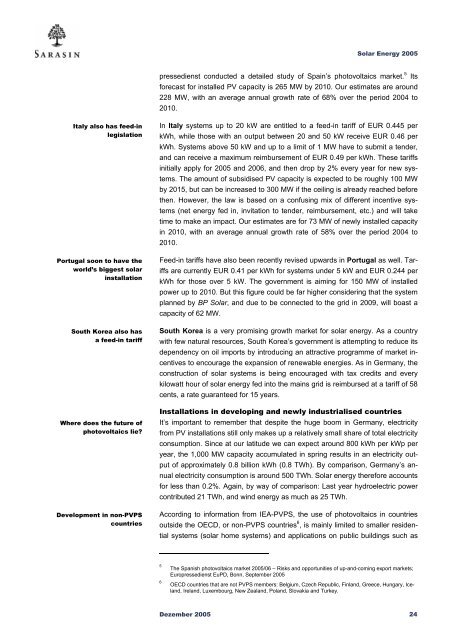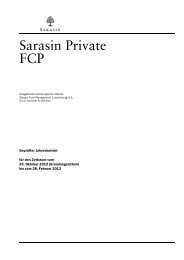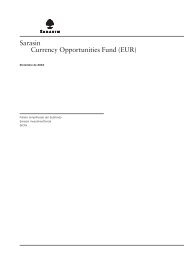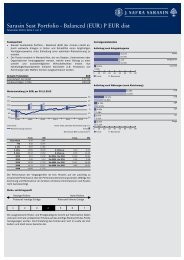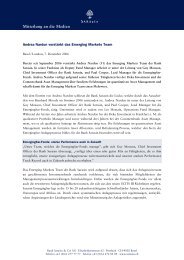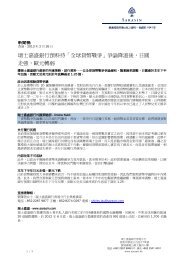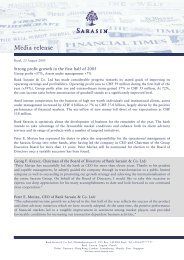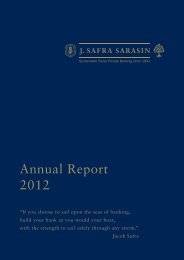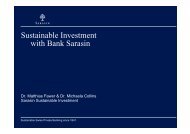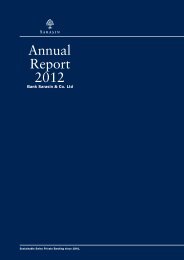Sustainability Report - Bank Sarasin-Alpen
Sustainability Report - Bank Sarasin-Alpen
Sustainability Report - Bank Sarasin-Alpen
Create successful ePaper yourself
Turn your PDF publications into a flip-book with our unique Google optimized e-Paper software.
Solar Energy 2005<br />
pressedienst conducted a detailed study of Spain’s photovoltaics market. 5 Its<br />
forecast for installed PV capacity is 265 MW by 2010. Our estimates are around<br />
228 MW, with an average annual growth rate of 68% over the period 2004 to<br />
2010.<br />
Italy also has feed-in<br />
legislation<br />
Portugal soon to have the<br />
world’s biggest solar<br />
installation<br />
South Korea also has<br />
a feed-in tariff<br />
Where does the future of<br />
photovoltaics lie?<br />
Development in non-PVPS<br />
countries<br />
In Italy systems up to 20 kW are entitled to a feed-in tariff of EUR 0.445 per<br />
kWh, while those with an output between 20 and 50 kW receive EUR 0.46 per<br />
kWh. Systems above 50 kW and up to a limit of 1 MW have to submit a tender,<br />
and can receive a maximum reimbursement of EUR 0.49 per kWh. These tariffs<br />
initially apply for 2005 and 2006, and then drop by 2% every year for new systems.<br />
The amount of subsidised PV capacity is expected to be roughly 100 MW<br />
by 2015, but can be increased to 300 MW if the ceiling is already reached before<br />
then. However, the law is based on a confusing mix of different incentive systems<br />
(net energy fed in, invitation to tender, reimbursement, etc.) and will take<br />
time to make an impact. Our estimates are for 73 MW of newly installed capacity<br />
in 2010, with an average annual growth rate of 58% over the period 2004 to<br />
2010.<br />
Feed-in tariffs have also been recently revised upwards in Portugal as well. Tariffs<br />
are currently EUR 0.41 per kWh for systems under 5 kW and EUR 0.244 per<br />
kWh for those over 5 kW. The government is aiming for 150 MW of installed<br />
power up to 2010. But this figure could be far higher considering that the system<br />
planned by BP Solar, and due to be connected to the grid in 2009, will boast a<br />
capacity of 62 MW.<br />
South Korea is a very promising growth market for solar energy. As a country<br />
with few natural resources, South Korea’s government is attempting to reduce its<br />
dependency on oil imports by introducing an attractive programme of market incentives<br />
to encourage the expansion of renewable energies. As in Germany, the<br />
construction of solar systems is being encouraged with tax credits and every<br />
kilowatt hour of solar energy fed into the mains grid is reimbursed at a tariff of 58<br />
cents, a rate guaranteed for 15 years.<br />
Installations in developing and newly industrialised countries<br />
It’s important to remember that despite the huge boom in Germany, electricity<br />
from PV installations still only makes up a relatively small share of total electricity<br />
consumption. Since at our latitude we can expect around 800 kWh per kWp per<br />
year, the 1,000 MW capacity accumulated in spring results in an electricity output<br />
of approximately 0.8 billion kWh (0.8 TWh). By comparison, Germany’s annual<br />
electricity consumption is around 500 TWh. Solar energy therefore accounts<br />
for less than 0.2%. Again, by way of comparison: Last year hydroelectric power<br />
contributed 21 TWh, and wind energy as much as 25 TWh.<br />
According to information from IEA-PVPS, the use of photovoltaics in countries<br />
outside the OECD, or non-PVPS countries 6 , is mainly limited to smaller residential<br />
systems (solar home systems) and applications on public buildings such as<br />
5<br />
6<br />
The Spanish photovoltaics market 2005/06 – Risks and opportunities of up-and-coming export markets;<br />
Europressedienst EuPD, Bonn, September 2005<br />
OECD countries that are not PVPS members: Belgium, Czech Republic, Finland, Greece, Hungary, Iceland,<br />
Ireland, Luxembourg, New Zealand, Poland, Slovakia and Turkey.<br />
Dezember 2005 24


